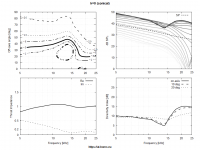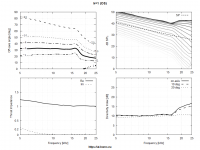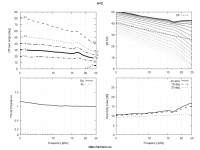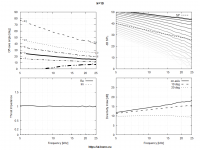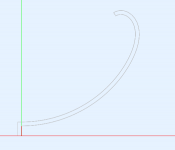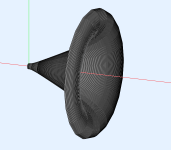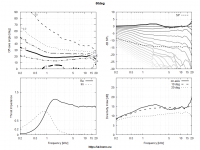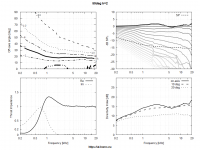So far we have seen a slight mismatch with exit angles. It might be interesting to see what happens if the horn and driver aren't centered properly or exhibit a slight groove at the seal between the two.
Something like that could be cured with the putty, but could also happen in real life when bolting the horn/driver together. To show this effect in a simulation might shine a light on the importance of the seal at the throat.
Something like that could be cured with the putty, but could also happen in real life when bolting the horn/driver together. To show this effect in a simulation might shine a light on the importance of the seal at the throat.
I have another set and I'll leave the rest for you guys (with Ath 4.7 this is really easy and a matter of minutes).
In all the following cases there's a flat wavefront at the throat (1").
Polar maps (top left) are normalized to 10 deg. The polars on top right are not normalized.
1) k = 0 (i.e. conical waveguide):

2) k = 1 (OS)

3) k = 2 (OS profile corresponding to 2" throat)

In all the following cases there's a flat wavefront at the throat (1").
Polar maps (top left) are normalized to 10 deg. The polars on top right are not normalized.
1) k = 0 (i.e. conical waveguide):
2) k = 1 (OS)
3) k = 2 (OS profile corresponding to 2" throat)
Attachments
Hi,
is there other trade offs using k value over 1 than the narrowing of the polar pattern? It looks like that "slower change" near the throat pushes the wiggle up higher. Does this mean that if a certain nominal polar pattern is the target one could decide on a bit deeper waveguide with a larger mouth that would provide better highs and maybe lows (if loading was a thing) by using k > 1 and adjusting the other parameters to get the desired polar pattern?
Everyone play with the K value here OS-SE Waveguide II if you haven't. Copied from #4719.
What happens if the k is 10, push the wiggle above 20kHz?😀 Amazing how the throat profile widens the wavefront in higher frequencies than the 1" / 13.5kHz.
ps. what the "k = 2 (OS profile corresponding to 2" throat)" means?
is there other trade offs using k value over 1 than the narrowing of the polar pattern? It looks like that "slower change" near the throat pushes the wiggle up higher. Does this mean that if a certain nominal polar pattern is the target one could decide on a bit deeper waveguide with a larger mouth that would provide better highs and maybe lows (if loading was a thing) by using k > 1 and adjusting the other parameters to get the desired polar pattern?
Everyone play with the K value here OS-SE Waveguide II if you haven't. Copied from #4719.
What happens if the k is 10, push the wiggle above 20kHz?😀 Amazing how the throat profile widens the wavefront in higher frequencies than the 1" / 13.5kHz.
ps. what the "k = 2 (OS profile corresponding to 2" throat)" means?
Last edited:
The narrowing (rise of DI with frequency) is the only drawback of k > 1 I'm aware of. The benefit is that it pushes the higher throat impedance lower in frequency, i.e. increases the loading. It also seems to kind of smoothen the DI curve in the top octave. Pick your poison.
k = X means that an OS profile otherwise corresponding to a X times larger throat is used. If you play with the OS-SE formula you will notice that the OS profile depends on the throat radius - the larger the radius, the less curved is the profile near the throat, i.e. the slower it expands.
k = X means that an OS profile otherwise corresponding to a X times larger throat is used. If you play with the OS-SE formula you will notice that the OS profile depends on the throat radius - the larger the radius, the less curved is the profile near the throat, i.e. the slower it expands.
Maybe an interesting thing about all these designs is that when the listener is located at 20 deg off-axis, he/she always receives the same spectral content of the direct sound as of the total radiated sound power, no matter the shape of the horn.
Last edited:
I think that is a very good characteristic that also will have a positive impact on general perception of fidelity.
//
//
Maybe an interesting thing about all these designs is that when the listener is located at 20 deg off-axis, he/she always receives the same spectral content of the direct sound as of the total radiated sound power, no matter the shape of the horn.
Ah yeah, the trade off then becomes between these, if ~20 deg listening axis with the ~45 deg toe in and equilateral triangle with the speakers and the main listening position:
1. flat DI
- some wiggle on highest frequencies ( above my hearing limit )
- wide listening window
- if the room hasn't too much damping, late reflections should be somewhat similar tone to the direct sound
2. or rising DI
- smooth directivity up the highest frequencies ( above anyone hearing limit )
- but listening window narrows
- late reflections get brigter (more HF energy to the 0 axis), if the room has some damping this might be better.
I mean it is the room and application and preference that would choose which one sounds better?
I think that k = 10 is way too high but something it the range 1 - 3 is perhaps worth considering, I don't know. Definitely, there's the option. Maybe with bigger throats it would make more sense. The 1" OS throat is basically problem-free.
Last edited:
Your formula seems very elegant from the paper, very powerful. Does mouth rollback need readjustment to preserve smooth response when the k is changed?
Hmm, I should buy a CNC, this is so fascinating 🙂
Hmm, I should buy a CNC, this is so fascinating 🙂
The rollback is applied as the last step on an existing OSSE profile, whatever that is, so the profile is smoothly "bended". There's no re-adjustment necessary, it will always be as smooth as it can be.
There are several degrees of freedom though.
There are several degrees of freedom though.
What I always wanted was a narrow CD. Less than 50 degrees before dropping 6db+.
50 degrees is really quite a wide area when it's drawn out in my living room, and would cover several seats, but this would also:
-Keep efficiency high (smaller radiating area)
- Allow reflections to have the same spectrum to on axis, but at a much reduced level making imaging excellent for the direction of voices.
Alas, such a horn in 1.5 inch with a low crossover is unicorn poo.
50 degrees is really quite a wide area when it's drawn out in my living room, and would cover several seats, but this would also:
-Keep efficiency high (smaller radiating area)
- Allow reflections to have the same spectrum to on axis, but at a much reduced level making imaging excellent for the direction of voices.
Alas, such a horn in 1.5 inch with a low crossover is unicorn poo.
The problem with narrow CD is that such waveguide would probably have to be unpractically big (and long) to maintain reasonably controlled directivity reasonably low in frequency. Narrow coverage waveguides are generally much harder to do.
The problem with narrow CD is that such waveguide would probably have to be unpractically big (and long) to maintain reasonably controlled directivity reasonably low in frequency. Narrow coverage waveguides are generally much harder to do.
I myself have a jmlc 350hz horn with a 1.5 inch throat.
It sounds spectacular, but you really cannot move your head far at all before loosing the treble.
I need to try CD now though to compare, but suspect a middle.griund will be needed
Stonking sound though. Voices are spine tingling.
With Ath/OS-SE you can easily "tune" a waveguide anywhere between exponential (JMLC) and pure conical. The new version will be released in a few days (I hope - still need to finish some code and the docs).
- Home
- Loudspeakers
- Multi-Way
- Acoustic Horn Design – The Easy Way (Ath4)
